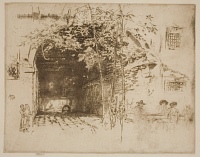The Traghetto, No. 2 | ||
| Number: | 233 | |
| Date: | 1880 | |
| Medium: | etching and drypoint | |
| Size: | 243 x 307 mm | |
| Signed: | butterfly at lower left (1-3); replaced with a butterfly further up (4-final) | |
| Inscribed: | no | |
| Set/Publication: | 'First Venice Set', 1880 | |
| No. of States: | 9 | |
| Known impressions: | 60 | |
| Catalogues: | K.191; M.188; W.156 | |
| Impressions taken from this plate (60) | ||
KEYWORD
arch, canal, children, courtyard, ferry, gondola, lantern, man seated, palace, , tree, wine, worker.
TITLE
There are minor variations in the title, as follows:
'The Traghetto' (1880, FAS). 1
'The Traghetto' (1886, Frederick Wedmore (1844-1921)). 2
'The Traghetto' (1887/1888, Whistler). 3
'The Traghetto. No. 2' (1909, Howard Mansfield (1849-1938)). 4
'The Traghetto, No. 2' (1910, Edward Guthrie Kennedy (1849-1932)). 5
The original title is 'The Traghetto' although this inevitably causes confusion with the earlier version of the subject, Traghetto 231. Thus 'The Traghetto, No. 2' is the preferred title.
'The Traghetto' (1880, FAS). 1
'The Traghetto' (1886, Frederick Wedmore (1844-1921)). 2
'The Traghetto' (1887/1888, Whistler). 3
'The Traghetto. No. 2' (1909, Howard Mansfield (1849-1938)). 4
'The Traghetto, No. 2' (1910, Edward Guthrie Kennedy (1849-1932)). 5
The original title is 'The Traghetto' although this inevitably causes confusion with the earlier version of the subject, Traghetto 231. Thus 'The Traghetto, No. 2' is the preferred title.
DESCRIPTION
In the centre is a broad arch, the entrance to a dark passageway underneath a building, leading to a canal. The passage is roofed with beams, and lit, towards the far end, by a lantern. Through the opening can be seen a seated man at the left, and the canopy of a gondola on the right. In the foreground, in a courtyard, are three slender trees with spreading foliage. In the wall to the left of the arch is a window with lozenge shaped panes, and at the right are two windows. At the right four men are seated about a table.
SITE

The
site is the courtyard of the Ca’ da Mosto, north of the
Rialto bridge in the district of Cannaregio, Venice, Italy. 6 This view, drawn accurately on the copper plate, is reversed, as usual, in the print. There is an earlier version of the scene, Traghetto 231.
6: Grieve 2000[more], pp. 83–84.
DISCUSSION
The Pennells discussed this etching with Whistler, comparing it with The Miser 017, The Kitchen 016 and The 'Adam and Eve', Old Chelsea 182:
'we said
that the Venetian plates seemed to be executed in an
absolutely new and original technique. It so happened that
the Adam and Eve, Old Chelsea, and The Traghetto [No. 2] were, as
they are now, hanging almost side by side on our walls.
In a five minutes' demonstration he proved one to be but
the outgrowth of the other, and had he carried the demonstration
further back, he could have proved that both, as
we can now see, grew out of The Coast Survey plate, and that
there was a natural and logical growth all the way through.' 7
Pennell got really carried away, comparing it with the work of Rembrandt Harmens van Rijn (1617-1681), to Whistler's advantage:
'In The Traghetto
in Venice, there is the same scheme as in the early prints of
The Miser and The Kitchen, but the Venice plate is more
painter-like in quality. Without taking away from the
etched line, he has given a fulness of tone which makes the
background of The Burgomaster Six seem weak in comparison.' 8
